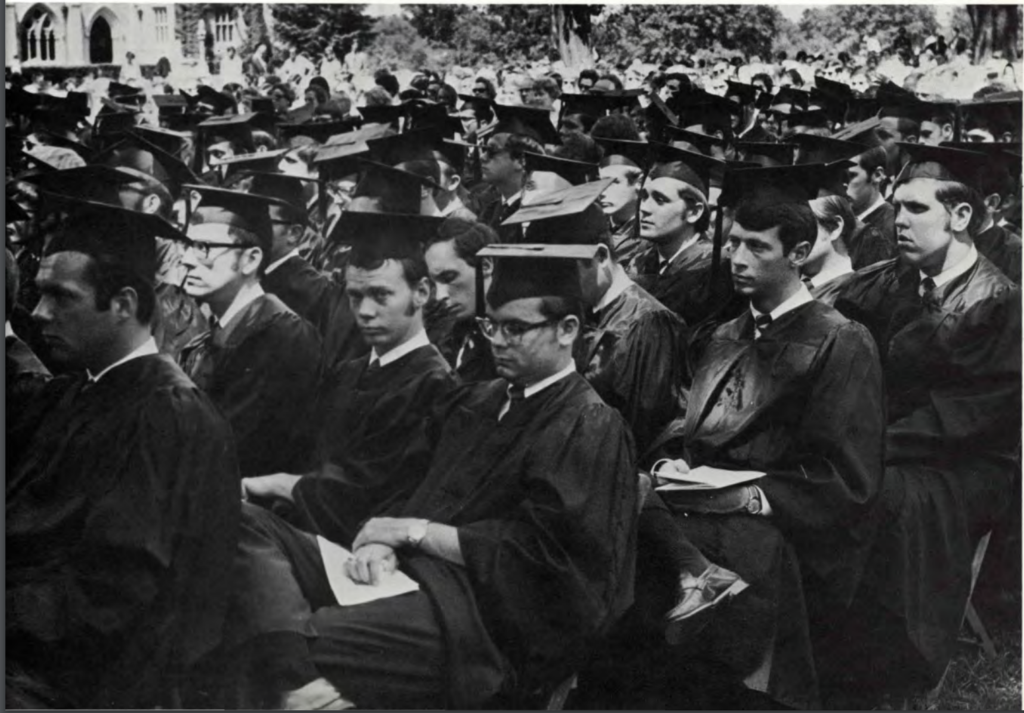Kat Namon ’22
Managing Editor
With the recent announcement of an in-person Commencement ceremony for the Class of 2021, the Tripod dove into the archives to look into how the traditions surrounding such a meaningful moment for students have changed over the years.

Although the oldest continuously observed tradition at the College is Matriculation, the event of Commencement has no shortage of unique aspects and ever changing additions to the often week-long festivities. During the early 20th century at Trinity, from 1904 onward, similar schedules have characterized the events of Commencement weekend.
During 1905, for instance, the order of events of Commencement consisted of the Class Day presentation, the Medusa Head Banquet, Class Day exercises on Monday afternoon, followed by the President’s address, oration, class poem, Commencement oration, Commencement ceremony, and then finally the valedictory address. 1905 also saw the presence of “senior antics,” a dramatic production of a “one-act farce entitled ‘Freezing a Mother-in-Law'” with an “extremely amusing” script according to a Tripod report.
Commencement at this time would have been held in the third or fourth week of June, as the semester continued far later than our contemporary calendar. The Tripod, too, continued its publication into June during those years, a marked contrast from today’s conclusion in early May prior to Commencement.
Class Day, the late Peter Knapp wrote in a survey of College traditions on the College’s 175th anniversary, sought to “call attention to the accomplishments of the graduating class and to emphasize the lasting bonds of friendship.” The ceremony begin in 1855 near a small white oak planted during the Totten administration of the 1840s on the Old Campus. Class Day continued until 1968 and also included the ceremonial planting of ivy in memory of a class and later the planting of ceremonial elms on the quad.
A tradition that remained for many years during Commencement events was the presentation of the Lemon Squeezer, always occurring on Class Day and first beginning in 1857 by William W. Niles, who later “taught Latin at Trinity and became the Bishop of the Episcopal Diocese of New Hampshire,” according to Knapp’s tract on traditions. During the first occurrence of the ceremony in 1857, Niles presented a wooden lemon squeezer to a member of the sophomore class, as recognition of the sophomores’ “aggregate excellence in scholarship” and “moral character.” Since the tradition’s conception in 1857, every Class Day has featured the passing down of the lemon squeezer to the “most popular rising class” and thus has instilled competition amongst students to earn the recognition. Although the tradition did not occur every year since its start, it was revived in 1950 when a representative of the senior class that year awarded the prize to “Trinity’s best remaining class,” the Class of 1952.
The original squeezer has, at various points throughout history, gone missing through senior and alumni antics alike, and today the tradition has been moved and occurs during Matriculation. In a celebrated snatching of the queezer in 1896, a student escaped on horseback and the squeezer was lost until being returned upon the pleading of Trinity President George Keith Funston ’32 in the late 1940s. The 1857 squeezer was again stolen in 1955 and was later returned in 1969. According to Knapp, the squeezer was stolen again a decade or so after the tradition was revived yet again by President James F. English in the 1980s and remains “at large.” The current squeezer, so far as is known, is a replica.
Another graduation tradition associated with Trinity traces its origins to 1918 with the installation of the Luther-Roosevelt Long Walk Inscription in the rectangular stone in front of the Fuller Arch at Northam Towers. The inscription features a quote that former U.S. President Theodore Roosevelt, a friend of President Flavel Sweeten Luther ’70, who delivered the 1918 Commencement address, organized the theme of his address around. The stone features a verse from the Bible, 1 Kings 20:11: “Let not him that girdeth on his harness boast himself as that putteth it off.” As Professor of Economics, Emeritus Ward Curran ’57 has noted, the tradition of not “stepping on the plaque” itself is a relatively contemporary one: prior to the 1970s, the Commencement stage faced outward toward the statue of Bishop Brownell (and students faced the Long Walk). Thus, the stage would have covered the plaque for much of the twentieth century.
Today, students avoid stepping on the plaque prior to their Commencement in fear that doing so would prevent them from receiving their diplomas. Seniors, on Commencement Day, will ceremonially step directly on the stone as they pass by it on their way to the ceremony.
Beginning in 1904, Commencement also saw a tradition of an annual alumni versus current students baseball game which took place on Trinity Field. Dance events such as the Senior Promenade were also popular and yielded a significant turnout from members of the graduating classes throughout the years, and in 1920 the Tripod reported that “dancing lasted until five o’clock Tuesday morning” when the event began Monday evening.
Newer, more modern traditions like “Tent City,” which consists of various events and parties on the athletic fields under white tents, have uncertain origins. The same goes for referring to events preceding Commencement as “Senior Week,” a more contemporary term that appears on occasion in the annals of the Tripod rather suddenly.
The Tripod welcomes its esteemed and knowledgeable readership, steeped in the history of Trinity, to share their own recollections and research on Commencements gone by. Please email your thoughts and historical musings to tripod@trincoll.edu for a chance to be featured in a future article.






+ There are no comments
Add yours